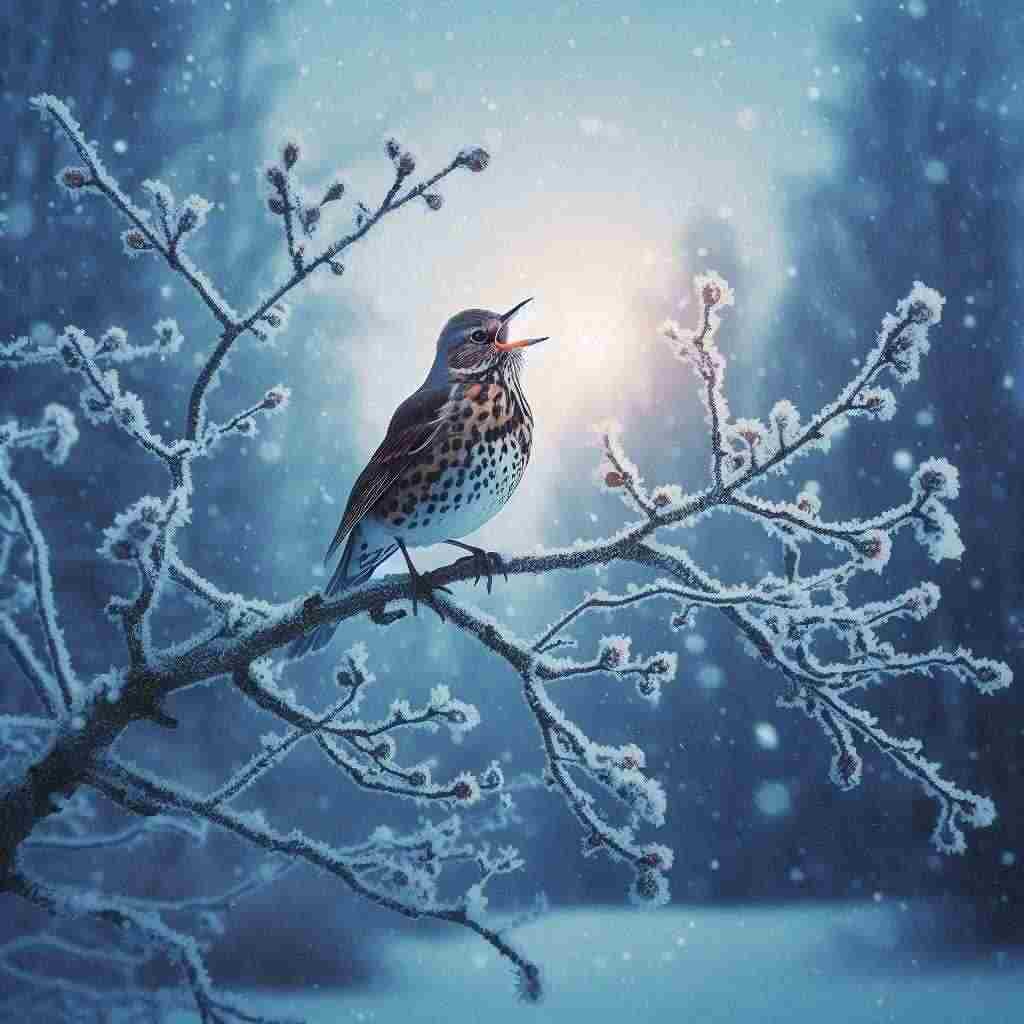The Darkling Thrush
Thomas Hardy
1840 to 1928

Want to track your favorites? Reopen or create a unique username. No personal details are required!
I leant upon a coppice gate
When Frost was spectre-grey,
And Winter's dregs made desolate
The weakening eye of day.
The tangled bine-stems scored the sky
Like strings of broken lyres,
And all mankind that haunted nigh
Had sought their household fires.
The land's sharp features seemed to be
The Century's corpse outleant,
His crypt the cloudy canopy,
The wind his death-lament.
The ancient pulse of germ and birth
Was shrunken hard and dry,
And every spirit upon earth
Seemed fervourless as I.
At once a voice arose among
The bleak twigs overhead
In a full-hearted evensong
Of joy illimited;
An aged thrush, frail, gaunt, and small,
In blast-beruffled plume,
Had chosen thus to fling his soul
Upon the growing gloom.
So little cause for carolings
Of such ecstatic sound
Was written on terrestrial things
Afar or nigh around,
That I could think there trembled through
His happy good-night air
Some blessed Hope, whereof he knew
And I was unaware.
Thomas Hardy's The Darkling Thrush
Thomas Hardy's poem "The Darkling Thrush" is a poignant exploration of the tension between despair and hope at the turn of the 19th century. Written on December 31, 1900, the poem captures a moment of transition, not just between day and night, or between seasons, but between centuries. Through vivid imagery and masterful use of contrast, Hardy paints a bleak winter landscape that serves as a metaphor for the poet's- and perhaps society's - gloomy outlook, only to be unexpectedly interrupted by a thrush's song of hope.
The poem opens with the speaker leaning on a "coppice gate," immediately establishing a sense of liminality - a threshold between two states. This liminal positioning is crucial to the poem's theme of transition and change. The landscape is described in terms that personify winter and evoke death: "Frost was spectre-grey," and the day's eye is "weakening," suggesting the dying light of both the day and, metaphorically, the century.
Hardy's use of imagery in the first two stanzas is particularly striking. The "tangled bine-stems" that score the sky "Like strings of broken lyres" create a visual representation of desolation while also introducing a musical motif that will be crucial later in the poem. The reference to mankind seeking "their household fires" further emphasizes the bleakness of the external world, with humanity retreating from the harsh landscape.
The third stanza takes the poem's somber tone to new heights, directly personifying the passing century as a corpse. This powerful metaphor encapsulates the speaker's sense that an era is ending, and with it, perhaps, the hopes and dreams of the past hundred years. The "cloudy canopy" as the century's crypt and the wind as its "death-lament" continue the funereal imagery, creating a pervasive atmosphere of death and decay.
Hardy extends this sense of lifelessness to the natural world and to humanity itself in the fourth stanza. The "ancient pulse of germ and birth" being "shrunken hard and dry" suggests a fundamental loss of vitality and fertility. The line "And every spirit upon earth / Seemed fervourless as I" universalizes the speaker's own lack of passion or hope, implying a widespread spiritual malaise.
It is at this bleakest moment that Hardy introduces the poem's turning point. The sudden appearance of the thrush's song in the fifth stanza marks a dramatic shift in tone. The bird's "full-hearted evensong / Of joy illimited" stands in stark contrast to the desolation that has been described up to this point. This juxtaposition is central to the poem's power and meaning.
Hardy's description of the thrush is significant. It is "aged, frail, gaunt, and small," with "blast-beruffled plume," suggesting that it too has been battered by the harsh conditions. Yet despite its apparent frailty, the bird chooses "to fling his soul / Upon the growing gloom." This act of defiance against the surrounding darkness is profoundly moving and serves as the poem's emotional core.
The final stanza grapples with the meaning of the thrush's song. The speaker acknowledges that there seems to be "So little cause for carolings / Of such ecstatic sound," given the bleakness of the surroundings. Yet the very existence of the song in such circumstances suggests to the speaker that there might be "Some blessed Hope" of which the bird is aware but the speaker is not.
This conclusion is ambiguous and complex. While it introduces a note of hope, it also underscores the speaker's disconnection from that hope. The thrush seems to possess a knowledge or faith that the speaker lacks, leaving him simultaneously uplifted by the bird's song and aware of his own spiritual poverty.
Throughout the poem, Hardy employs a consistent ABABCDCD rhyme scheme and iambic tetrameter, giving the work a musical quality that echoes its content. This structured form contrasts with the chaotic and desolate imagery, perhaps suggesting an underlying order or potential for harmony even in apparent disorder.
"The Darkling Thrush" is a masterful exploration of the human experience of transition and uncertainty. It captures a moment of historical significance - the turn of a century - and uses it to explore timeless themes of despair, hope, and the resilience of the spirit. Through its vivid imagery, careful structure, and powerful contrasts, the poem invites readers to consider their own relationship to hope in the face of apparent desolation, and to remain open to unexpected sources of joy and renewal.
This text was generated by AI and is for reference only. Learn more

